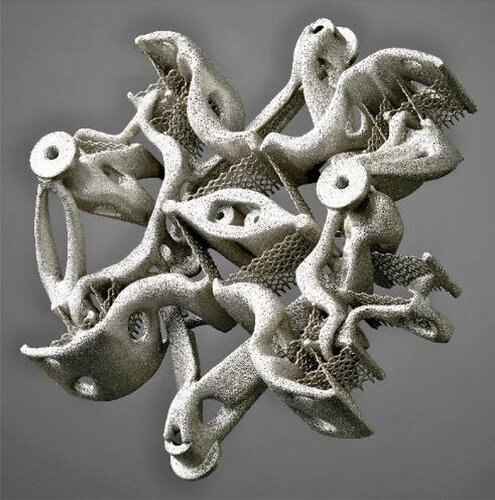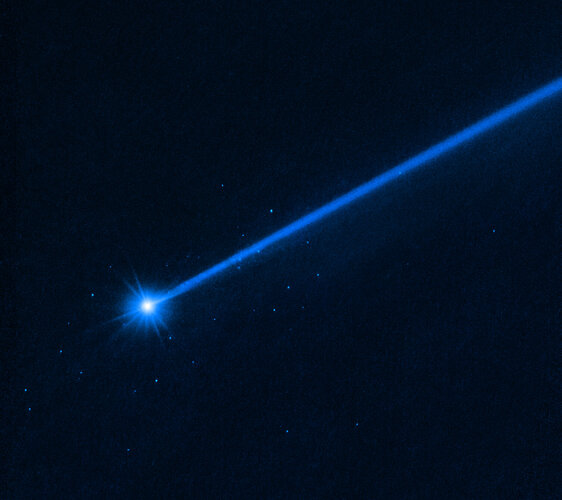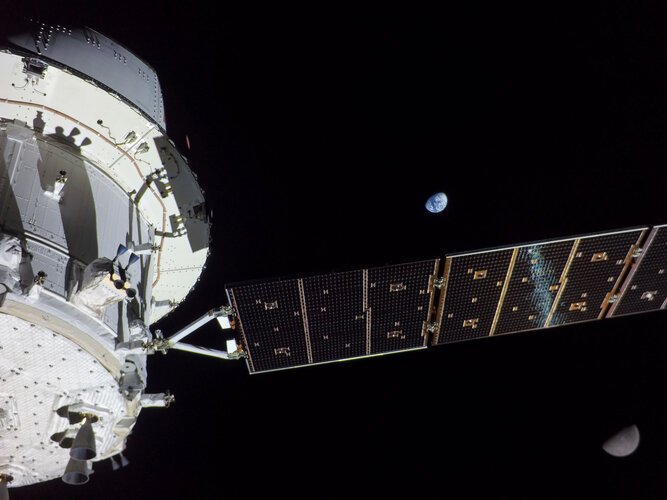
Copernical Team
Thursday, 20 July 2023 12:50
3D-printed bend-based mechanism
 Image:
3D-printed bend-based mechanism
Image:
3D-printed bend-based mechanism
Published in
News
Tagged under
Thursday, 20 July 2023 13:00
Hubble sees boulders escaping from asteroid Dimorphos

Astronomers taking advantage of the NASA/ESA Hubble Space Telescope’s extraordinary sensitivity have discovered a swarm of boulders that were possibly shaken off the asteroid Dimorphos when NASA deliberately slammed the half-tonne DART impactor spacecraft into Dimorphos at approximately 22 500 km per hour. DART intentionally impacted Dimorphos on 26 September 2022, slightly changing the trajectory of its orbit around the larger asteroid Didymos.
Published in
News
Tagged under
Thursday, 20 July 2023 08:15
Lunar encore
 Image:
Dividing Earth and Moon
Image:
Dividing Earth and Moon
Published in
News
Tagged under
Thursday, 20 July 2023 08:59
Flat sapphire windows for hypersonic aircraft and weapons
Providence RI (SPX) Jul 19, 2023
 Custom fabricated sapphire windows that are ideally suited for protecting sensitive vision systems and sensors in hypersonic aircraft and weapon systems have been introduced by Meller Optics, Inc. of Providence, RI.
Meller Flat Sapphire Windows feature Mohs 9 hardness, which is second only to diamond, and can withstand temps. up to 1,000+ C, pressures to 10,000 psi, and are chemically iner
Custom fabricated sapphire windows that are ideally suited for protecting sensitive vision systems and sensors in hypersonic aircraft and weapon systems have been introduced by Meller Optics, Inc. of Providence, RI.
Meller Flat Sapphire Windows feature Mohs 9 hardness, which is second only to diamond, and can withstand temps. up to 1,000+ C, pressures to 10,000 psi, and are chemically iner
 Custom fabricated sapphire windows that are ideally suited for protecting sensitive vision systems and sensors in hypersonic aircraft and weapon systems have been introduced by Meller Optics, Inc. of Providence, RI.
Meller Flat Sapphire Windows feature Mohs 9 hardness, which is second only to diamond, and can withstand temps. up to 1,000+ C, pressures to 10,000 psi, and are chemically iner
Custom fabricated sapphire windows that are ideally suited for protecting sensitive vision systems and sensors in hypersonic aircraft and weapon systems have been introduced by Meller Optics, Inc. of Providence, RI.
Meller Flat Sapphire Windows feature Mohs 9 hardness, which is second only to diamond, and can withstand temps. up to 1,000+ C, pressures to 10,000 psi, and are chemically iner
Published in
News
Tagged under
Thursday, 20 July 2023 08:59
China unveils cutting-edge JF-22 Hypersonic Wind Tunnel facility
Sydney, Australia (SPX) Jul 19, 2023
 China Media Group's recent video coverage has brought into the limelight the revolutionary JF-22 hypersonic wind tunnel. This technologically advanced wind tunnel has successfully passed stringent quality tests and is currently regarded as the world's premier facility of its kind.
The primary function of the JF-22 is to facilitate a plethora of simulated flight experiments, pivotal during
China Media Group's recent video coverage has brought into the limelight the revolutionary JF-22 hypersonic wind tunnel. This technologically advanced wind tunnel has successfully passed stringent quality tests and is currently regarded as the world's premier facility of its kind.
The primary function of the JF-22 is to facilitate a plethora of simulated flight experiments, pivotal during
 China Media Group's recent video coverage has brought into the limelight the revolutionary JF-22 hypersonic wind tunnel. This technologically advanced wind tunnel has successfully passed stringent quality tests and is currently regarded as the world's premier facility of its kind.
The primary function of the JF-22 is to facilitate a plethora of simulated flight experiments, pivotal during
China Media Group's recent video coverage has brought into the limelight the revolutionary JF-22 hypersonic wind tunnel. This technologically advanced wind tunnel has successfully passed stringent quality tests and is currently regarded as the world's premier facility of its kind.
The primary function of the JF-22 is to facilitate a plethora of simulated flight experiments, pivotal during
Published in
News
Tagged under
Thursday, 20 July 2023 08:59
Has the standard cosmological model been broken or just cracked
Berlin, Germany (SPX) Jul 20, 2023
 A global consortium of astrophysicists spearheaded by teams from the Max Planck Institute for Astrophysics in Germany, Harvard University in the United States, and Durham University in the United Kingdom, have taken a bold stride towards understanding the cosmos. The team has recently simulated the formation of galaxies and cosmic structures across vast expanses of space.
A unique aspect o
A global consortium of astrophysicists spearheaded by teams from the Max Planck Institute for Astrophysics in Germany, Harvard University in the United States, and Durham University in the United Kingdom, have taken a bold stride towards understanding the cosmos. The team has recently simulated the formation of galaxies and cosmic structures across vast expanses of space.
A unique aspect o
 A global consortium of astrophysicists spearheaded by teams from the Max Planck Institute for Astrophysics in Germany, Harvard University in the United States, and Durham University in the United Kingdom, have taken a bold stride towards understanding the cosmos. The team has recently simulated the formation of galaxies and cosmic structures across vast expanses of space.
A unique aspect o
A global consortium of astrophysicists spearheaded by teams from the Max Planck Institute for Astrophysics in Germany, Harvard University in the United States, and Durham University in the United Kingdom, have taken a bold stride towards understanding the cosmos. The team has recently simulated the formation of galaxies and cosmic structures across vast expanses of space.
A unique aspect o
Published in
News
Tagged under
Thursday, 20 July 2023 08:59
Stratospheric success for BAE Systems' PHASA-35 UAV drone
London, UK (SPX) Jul 14, 2023
 In a groundbreaking development, British engineers have successfully piloted the High Altitude Pseudo Satellite (HAPS) Uncrewed Aerial System (UAS) - PHASA-35 - to complete its first stratospheric flight. BAE Systems, a global leader in defence, aerospace, and security, conducted the trial last month in New Mexico, USA.
During the trial, PHASA-35 ascended over 66,000 feet into the stratosp
In a groundbreaking development, British engineers have successfully piloted the High Altitude Pseudo Satellite (HAPS) Uncrewed Aerial System (UAS) - PHASA-35 - to complete its first stratospheric flight. BAE Systems, a global leader in defence, aerospace, and security, conducted the trial last month in New Mexico, USA.
During the trial, PHASA-35 ascended over 66,000 feet into the stratosp
 In a groundbreaking development, British engineers have successfully piloted the High Altitude Pseudo Satellite (HAPS) Uncrewed Aerial System (UAS) - PHASA-35 - to complete its first stratospheric flight. BAE Systems, a global leader in defence, aerospace, and security, conducted the trial last month in New Mexico, USA.
During the trial, PHASA-35 ascended over 66,000 feet into the stratosp
In a groundbreaking development, British engineers have successfully piloted the High Altitude Pseudo Satellite (HAPS) Uncrewed Aerial System (UAS) - PHASA-35 - to complete its first stratospheric flight. BAE Systems, a global leader in defence, aerospace, and security, conducted the trial last month in New Mexico, USA.
During the trial, PHASA-35 ascended over 66,000 feet into the stratosp
Published in
News
Tagged under
Thursday, 20 July 2023 08:59
Future of Satellite Internet: OneWeb vs Starlink
Los Angeles CA (SPX) Jul 20, 2023
 Satellite constellations may well be the future of the Internet because they can ensure fibre-free coverage even in the most remote corners of the world. So, it should come as no surprise that many companies are already working in this direction. Elon Musk's Starlink and UK-based OneWeb were one of the first companies to have grasped the potential of satellite Internet, and it's more than probab
Satellite constellations may well be the future of the Internet because they can ensure fibre-free coverage even in the most remote corners of the world. So, it should come as no surprise that many companies are already working in this direction. Elon Musk's Starlink and UK-based OneWeb were one of the first companies to have grasped the potential of satellite Internet, and it's more than probab
 Satellite constellations may well be the future of the Internet because they can ensure fibre-free coverage even in the most remote corners of the world. So, it should come as no surprise that many companies are already working in this direction. Elon Musk's Starlink and UK-based OneWeb were one of the first companies to have grasped the potential of satellite Internet, and it's more than probab
Satellite constellations may well be the future of the Internet because they can ensure fibre-free coverage even in the most remote corners of the world. So, it should come as no surprise that many companies are already working in this direction. Elon Musk's Starlink and UK-based OneWeb were one of the first companies to have grasped the potential of satellite Internet, and it's more than probab
Published in
News
Tagged under
Thursday, 20 July 2023 06:39
Shenzhou XVI crew set to conduct their first EVA
Sydney, Australia (SPX) Jul 20, 2023
 The Shenzhou 16 astronauts aboard China's Tiangong Sspace Station are set for their first-ever spacewalk, as confirmed by the China Manned Space Agency.
In a recent press statement issued on Wednesday, the agency affirmed that the Shenzhou XVI team, which includes Commander Major General Jing Haipeng, Colonel Zhu Yangzhu, a spaceflight engineer, and Professor Gui Haichao, the science paylo
The Shenzhou 16 astronauts aboard China's Tiangong Sspace Station are set for their first-ever spacewalk, as confirmed by the China Manned Space Agency.
In a recent press statement issued on Wednesday, the agency affirmed that the Shenzhou XVI team, which includes Commander Major General Jing Haipeng, Colonel Zhu Yangzhu, a spaceflight engineer, and Professor Gui Haichao, the science paylo
 The Shenzhou 16 astronauts aboard China's Tiangong Sspace Station are set for their first-ever spacewalk, as confirmed by the China Manned Space Agency.
In a recent press statement issued on Wednesday, the agency affirmed that the Shenzhou XVI team, which includes Commander Major General Jing Haipeng, Colonel Zhu Yangzhu, a spaceflight engineer, and Professor Gui Haichao, the science paylo
The Shenzhou 16 astronauts aboard China's Tiangong Sspace Station are set for their first-ever spacewalk, as confirmed by the China Manned Space Agency.
In a recent press statement issued on Wednesday, the agency affirmed that the Shenzhou XVI team, which includes Commander Major General Jing Haipeng, Colonel Zhu Yangzhu, a spaceflight engineer, and Professor Gui Haichao, the science paylo
Published in
News
Tagged under
Thursday, 20 July 2023 06:39
Wind River VxWorks software chosen for Astroscale's Space Debris Solution ELSA-M
Sydney, Australia (SPX) Jul 20, 2023
 Wind River, an industry leader in intelligent system software, has announced that its VxWorks software will be utilized in the command of the Astroscale ELSA-M Servicer spacecraft's On-Board Computer (OBC). This announcement reflects Wind River's ongoing commitment to supporting the unique challenges and complexities of space missions.
Astroscale, a company dedicated to developing innovati
Wind River, an industry leader in intelligent system software, has announced that its VxWorks software will be utilized in the command of the Astroscale ELSA-M Servicer spacecraft's On-Board Computer (OBC). This announcement reflects Wind River's ongoing commitment to supporting the unique challenges and complexities of space missions.
Astroscale, a company dedicated to developing innovati
 Wind River, an industry leader in intelligent system software, has announced that its VxWorks software will be utilized in the command of the Astroscale ELSA-M Servicer spacecraft's On-Board Computer (OBC). This announcement reflects Wind River's ongoing commitment to supporting the unique challenges and complexities of space missions.
Astroscale, a company dedicated to developing innovati
Wind River, an industry leader in intelligent system software, has announced that its VxWorks software will be utilized in the command of the Astroscale ELSA-M Servicer spacecraft's On-Board Computer (OBC). This announcement reflects Wind River's ongoing commitment to supporting the unique challenges and complexities of space missions.
Astroscale, a company dedicated to developing innovati
Published in
News
Tagged under

